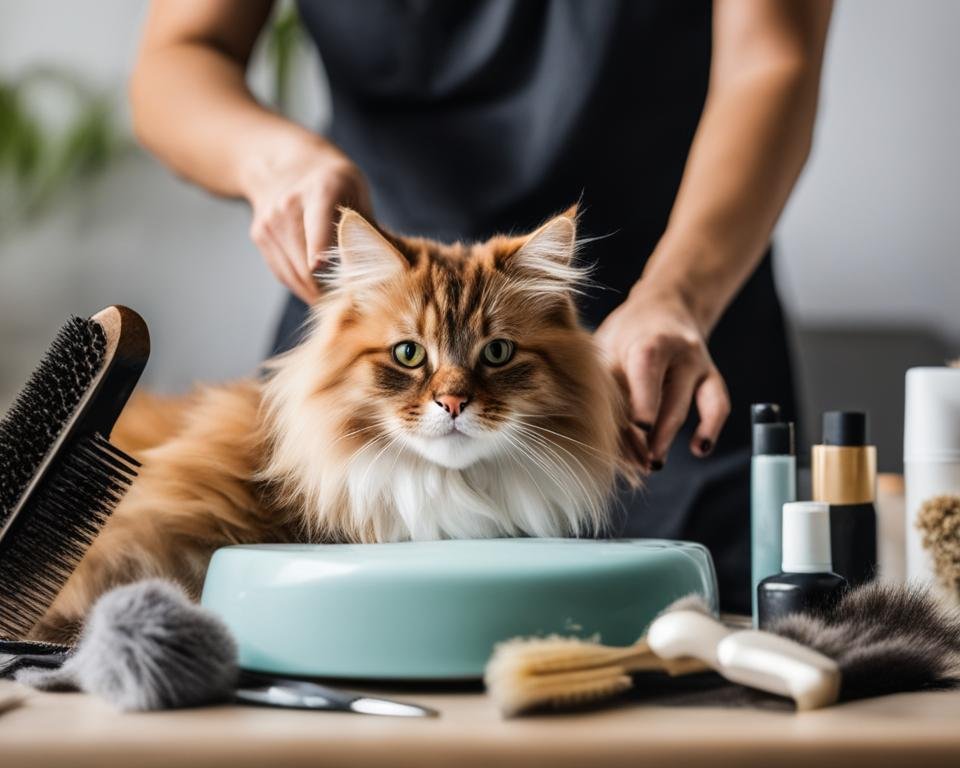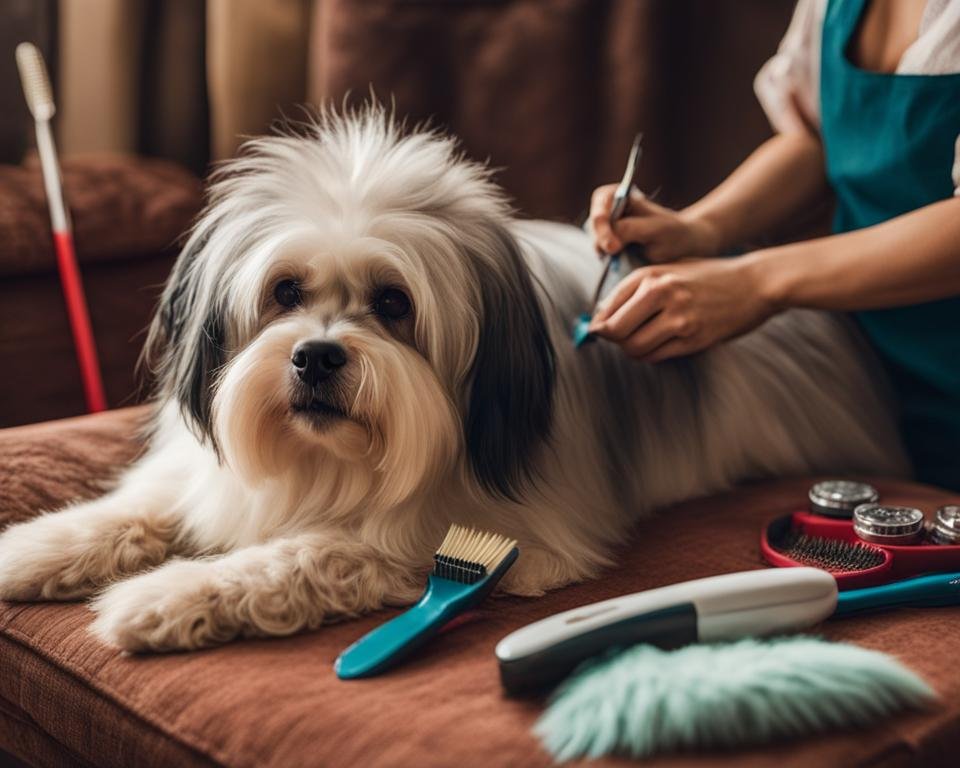Welcome to my blog where I’ll be sharing valuable tips and techniques to pamper your pet with expert DIY grooming. Taking care of your pet’s grooming needs at home not only saves you money but also strengthens the bond between you and your furry friend. In this section, we will explore the benefits of at-home pet grooming, essential techniques, and the supplies you’ll need to get started. Get ready to unleash your inner groomer!
Key Takeaways:
- DIY grooming allows you to save money and spend quality time with your pet.
- Grooming your pet at home promotes a stronger bond and trust between you and your furry friend.
- Essential grooming techniques include brushing, bathing, nail trimming, and ear cleaning.
- Choosing the right grooming supplies is crucial for a successful DIY grooming session.
- This section will guide you through professional grooming techniques and how to adapt to different seasons.
Understanding The Benefits of At-Home Pet Grooming
In this section, we will explore the various benefits of at-home pet grooming. Regular grooming not only enhances the physical appearance of your pet but also has several health benefits, such as preventing matting and skin infections. Additionally, grooming your pet provides an opportunity to build a stronger bond and trust between you and your furry friend. We will also discuss the cost-effectiveness of DIY grooming compared to professional grooming services.
Health Impacts of Regular Grooming
Regular grooming plays a vital role in maintaining your pet’s overall health and well-being. By grooming your pet at home, you can keep their coat clean and free from mats, which can cause discomfort and lead to skin infections. Brushing their fur helps to remove loose hair and prevents the formation of painful tangles. Additionally, regular nail trimming prevents overgrowth and reduces the risk of nail-related injuries. By incorporating grooming into your pet’s routine, you can contribute to their overall health and happiness.
Building a Stronger Bond with Your Pet
Grooming your pet provides an excellent opportunity to strengthen the bond between you and your furry companion. The sensory experience of grooming, such as gentle brushing and bathing, can be soothing and calming for your pet. It allows you to spend quality time together, showing them love and care. Regular grooming sessions create a positive association with touch, making your pet feel more comfortable and trusting in your presence. Through grooming, you can deepen your connection and build a stronger bond with your beloved pet.
Cost-Effectiveness of DIY Grooming
One of the significant advantages of at-home pet grooming is its cost-effectiveness. Professional grooming services can be expensive, especially for breeds that require frequent grooming sessions. By learning to groom your pet at home, you can save money in the long run. Investing in essential grooming supplies and learning the necessary techniques allows you to maintain your pet’s grooming needs without breaking the bank. DIY grooming also provides flexibility, as you can groom your pet whenever it is convenient for you, saving both time and money.
Essential DIY Pet Grooming Techniques
In this section, I will provide you with essential DIY pet grooming techniques that will help you maintain your pet’s hygiene and appearance at home. By mastering these techniques, you can save money and ensure your pet stays healthy and happy. Let’s dive in!
1. Brushing
Brushing is an important part of regular pet grooming. It helps remove loose hair, prevents mats and tangles, and keeps your pet’s coat looking shiny and healthy. Choose a brush that suits your pet’s coat type. For short-haired breeds, use a bristle brush or a grooming glove. For long-haired breeds, opt for slicker brushes or deshedding tools.
When brushing, start from the head and work your way down to the tail, following the direction of the hair growth. Be gentle and take your time to avoid hurting your pet’s skin. If you encounter any mats or tangles, use a detangling spray or a dematting tool to carefully remove them.
2. Bathing
Bathing your pet is essential to keep them clean and fresh. Use a gentle pet shampoo that is specifically formulated for your pet’s coat and skin type. Before bathing, brush your pet’s coat to remove any loose hair or tangles.
Fill a tub or sink with warm water and place a non-slip mat at the bottom to ensure your pet feels secure. Wet your pet thoroughly, avoiding their ears and eyes. Apply the shampoo and gently massage it into their coat. Rinse thoroughly to remove all the shampoo and towel dry your pet. If your pet has a thick coat, you may need to blow dry using a pet-safe blow dryer on a low heat setting.
3. Nail Trimming
Nail trimming is important to prevent your pet’s nails from becoming too long and causing discomfort. Use a sharp, pet-friendly nail clipper or grinder to trim the nails. Be cautious not to cut too close to the quick, which is the sensitive part of the nail.
If your pet has clear nails, you can easily see the pink quick inside. However, if your pet has dark nails, it’s best to trim a small amount at a time to avoid cutting into the quick. If you’re unsure, consult your veterinarian or a professional groomer for guidance.
4. Ear Cleaning
Ear cleaning is essential to prevent infections and maintain your pet’s ear health. Use a pet-specific ear cleaner and cotton balls or pads. Gently lift your pet’s ear flap and apply a small amount of ear cleaner into the ear canal. Massage the base of the ear to distribute the cleaner and then use a cotton ball or pad to wipe away any dirt or debris.
Be cautious not to insert anything deep into the ear canal, as it can cause injury. If you notice any redness, swelling, or discharge, consult your veterinarian.
Now that you have learned these essential DIY pet grooming techniques, you can confidently groom your furry friend at home. Remember to be patient, gentle, and always prioritize your pet’s safety and well-being.

DIY Grooming Supplies: What You Need for At-Home Pet Care
When it comes to DIY pet grooming, having the right supplies is essential. In this section, I will guide you through the must-have grooming tools and products for at-home pet care. From choosing the right brushes and combs to selecting DIY grooming shampoos and conditioners, I’ve got you covered. Let’s dive in!
Choosing the Right Brushes and Combs
The first step in grooming your pet at home is selecting the right brushes and combs for their coat type. Different coat textures require specific grooming tools to ensure effective and gentle brushing. Here are some common types of brushes and combs:
- Bristle Brushes: Suitable for all coat types, these brushes have firm bristles that help remove loose hair and distribute natural oils.
- Slicker Brushes: Ideal for removing tangles and mats, slicker brushes have fine, short wires close together.
- Pin Brushes: These brushes have long, rounded pins that are great for pets with medium to long hair. They help detangle and remove loose hair.
- Comb: A comb with wide and narrow teeth is useful for removing tangles and checking for any remaining mats.
Remember to choose brushes and combs that are specifically designed for pets to ensure their safety and comfort during grooming sessions.
DIY Grooming Shampoos and Conditioners
Using the right grooming products is crucial for maintaining your pet’s coat hygiene and health. When it comes to DIY grooming, choosing the right shampoos and conditioners is essential. Look for products that are specifically formulated for pets and free from harsh chemicals. Some key points to consider:
- Natural Ingredients: Opt for products that contain natural ingredients like oatmeal, aloe vera, or coconut oil, which are gentle and soothing for your pet’s skin.
- Hypoallergenic Formulas: If your pet has sensitive skin or allergies, use hypoallergenic products that are free from potential irritants.
- Coat-Specific Products: Different coat types require different care. Choose shampoos and conditioners that cater to your pet’s specific needs, such as moisturizing formulas for dry coats or detangling formulas for long hair.
By selecting the right grooming products, you can keep your pet’s coat clean, healthy, and free from irritation.
Must-Have Trimmers and Clippers
In addition to brushes and shampoos, having the right trimmers and clippers is essential for maintaining your pet’s hair and nail health. Here are some must-have tools for at-home pet grooming:
- Nail Trimmers: Regular nail trims help prevent overgrowth and nail-related injuries. Look for nail trimmers with safety features that prevent cutting too close to the quick.
- Hair Clippers: If you have a long-haired pet, investing in a quality pair of clippers is a great idea. Clippers help keep your pet’s hair at a manageable length between grooming sessions.
- Ear Trimmers: For pets with hairy ear canals, ear trimmers are essential for keeping the ears clean and preventing infections.
When using trimmers and clippers, follow instructions carefully to ensure your pet’s safety and comfort. Regular maintenance and cleaning of these tools are also important to keep them in optimal condition.
Now that you know the essential DIY grooming supplies, you’re well-equipped to take care of your furry friend’s grooming needs at home. Remember to choose the right brushes and combs, select gentle and pet-friendly shampoos and conditioners, and invest in quality trimmers and clippers. Happy grooming!
Professional Pet Grooming Techniques For Beginners
Are you ready to take your pet grooming skills to the next level? In this section, I will introduce you to professional pet grooming techniques that are perfect for beginners. With these techniques, you can achieve salon-quality results right at home.
“Grooming is not just about making your pet look good; it is also essential for their overall health and well-being.” – Professional Groomer
One of the most important techniques to master is scissoring. Whether it’s tidying up your pet’s facial hair or giving them a trim all over, using scissors correctly can make a big difference in the final look. Remember to start slowly and trim small sections at a time to avoid any accidents.
Another technique that can elevate your grooming game is blending. This technique involves using clippers and scissors together to create a seamless transition between different lengths of hair. By blending the shorter and longer areas of your pet’s coat, you can achieve a polished and professional finish.
Now that you know about scissoring and blending, let’s dive into the step-by-step instructions for these professional pet grooming techniques:
- Start by gathering all the necessary tools, including scissors, clippers, combs, and brushes.
- Prepare your pet by giving them a thorough brushing to remove any tangles or knots.
- If using clippers, choose the right blade length based on the desired haircut and your pet’s coat type.
- Begin by trimming small sections of hair at a time, working your way around your pet’s body.
- Use scissors to trim any areas that require more precision, such as the face, ears, and tail.
- Remember to take breaks and give your pet plenty of praise and treats throughout the grooming session.
- After you finish grooming, give your pet a final brush to remove any loose hair.
By following these step-by-step instructions and practicing regularly, you’ll soon become proficient in professional pet grooming techniques.
Now, take a look at the image below to get a visual representation of the scissoring technique in action:
Beginner’s Guide to Professional Pet Grooming Techniques
| Technique | Description |
|---|---|
| Scissoring | The art of using scissors to trim and shape your pet’s hair for a polished look. |
| Blending | Creating a seamless transition between different lengths of hair using clippers and scissors. |
With a little practice and patience, you’ll soon be able to groom your pet like a professional. So, get ready to unleash your inner pet stylist and give your furry friend the pampering they deserve!
Bathing Your Pet: A Step-by-Step Guide
Pre-bath Considerations
Before you begin the bathing process, there are a few pre-bath considerations to keep in mind. This will ensure that the bathing experience is stress-free and enjoyable for both you and your pet.
- Brush your pet’s fur thoroughly to remove any tangles, mats, or debris.
- Trim your pet’s nails to prevent scratching during the bath.
- Gather all the necessary bathing supplies, including a mild pet shampoo and towels.

The Bathing Process
Now that you’ve prepared everything, it’s time to start the bathing process.
- Fill a bathtub or basin with lukewarm water. Make sure the water level is shallow enough for your pet to stand comfortably.
- Gently place your pet in the water, supporting them if needed. Use a handheld showerhead or a pitcher to wet their fur thoroughly, starting from the neck and working your way down to the tail.
- Apply a small amount of pet shampoo to your hands and lather it onto your pet’s fur, avoiding their eyes, ears, and mouth.
- Massage the shampoo into their coat to ensure it reaches the skin and effectively removes dirt and oils.
- Rinse your pet thoroughly with lukewarm water until all the shampoo is washed out.
- Use a towel to gently dry your pet, being careful not to rub too vigorously.
- If your pet has a long or thick coat, you may consider using a pet dryer on a low heat setting to help speed up the drying process. Be sure to keep the dryer at a safe distance to prevent overheating.
Post-bath Practices for Pet Comfort
Once your pet is clean and dry, there are a few post-bath practices you can follow to ensure their comfort and well-being.
- Give your pet a treat or reward for their cooperation during the bath.
- Brush their fur again to remove any remaining tangles and promote good circulation.
- Check their ears for any signs of redness, discharge, or odor, as these may indicate an infection.
- If your pet has long hair, consider using a detangling spray or conditioner to keep their fur manageable.
- Monitor your pet for any signs of discomfort or allergies following the bath. If you notice any unusual behavior or skin reactions, consult your veterinarian.
Comparing Different Shampoo Types
| Shampoo Type | Key Features | Recommended For |
|---|---|---|
| Regular Pet Shampoo | Gentle formula suitable for most pets | Pets with normal skin and coat |
| Medicated Shampoo | Contains active ingredients to treat specific skin conditions | Pets with skin allergies, infections, or dermatitis |
| Hypoallergenic Shampoo | Free of common allergens, suitable for sensitive pets | Pets with allergies or sensitive skin |
| Natural/Organic Shampoo | Chemical-free formula made from natural ingredients | Pets with sensitivities to synthetic ingredients |
Grooming Tools for DIY Pet Grooming: How to Properly Use Them
When it comes to DIY pet grooming, having the right tools is essential for achieving professional results. In this section, I will provide a comprehensive guide on the different grooming tools available and how to use them properly. From brushes and combs to trimmers and clippers, understanding the purpose and technique of each tool is key to successful grooming at home.
Brushes: There are various types of brushes available for different coat types. Slicker brushes work well for removing tangles and mats, while bristle brushes are effective for distributing natural oils and giving the coat a smooth finish. Pin brushes are suitable for long-haired breeds, and rubber brushes are great for removing loose hair.
Combs: Combs are ideal for detangling and removing knots. A wide-toothed comb is useful for removing tangles in long, thick coats, while a fine-toothed comb is better for finer hair or removing debris.
Trimmers: Trimmers are handy for trimming excess hair in delicate areas such as the face, paws, and ears. Choose trimmers with adjustable blades, and always exercise caution to avoid injury. It’s best to consult a professional groomer or veterinarian if you’re unsure about using trimmers.
Clippers: Clippers are essential for trimming your pet’s hair to a desired length. Choose clippers suitable for your pet’s coat type and length. It’s important to regularly clean and oil the blades to ensure smooth and effective clipping.
Using grooming tools properly is vital to prevent harm or discomfort to your pet. Remember to always start with a clean and well-maintained tool, and be gentle and patient throughout the grooming process. If you’re uncertain about using certain tools, consult a professional groomer for guidance. Now, let’s take a look at the proper technique for using these grooming tools.
Brushing Technique:
- Start by brushing in the direction of hair growth, using long, gentle strokes to remove tangles and mats.
- Pay attention to sensitive areas like the stomach, groin, and underarms.
- Use a comb to remove any remaining knots or debris.
- Be cautious around sensitive areas like the face and ears, using a gentle hand.
Trimming Technique:
- Ensure your pet is calm and relaxed before attempting any trimming.
- Start by trimming small, manageable sections at a time.
- Be mindful of your pet’s comfort and avoid clipping too close to the skin or sensitive areas.
- Apply gentle pressure to avoid accidental cuts or nicks.
Clipping Technique:
- Before clipping, ensure your pet’s coat is clean and tangle-free.
- Begin with a longer blade setting and gradually adjust as needed for desired length.
- Move the clippers in the direction of hair growth, using gentle and confident strokes.
- Pay attention to sensitive areas and be cautious to avoid accidental snags or cuts.
Remember, practice makes perfect! Don’t be discouraged if you don’t achieve salon-worthy results right away. With time and patience, you’ll become more skilled in using grooming tools and providing your beloved pet with a comfortable and enjoyable grooming experience.
Grooming Tips for Pets with Special Needs
Caring for Senior Pets
When grooming senior pets, it’s essential to take into consideration their specific needs and limitations. Older pets may have mobility issues, arthritis, or sensitive skin, so it’s crucial to groom them with extra care and attention. Here are some grooming tips for senior pets:
- Use a non-slip surface while grooming to prevent accidents and falls.
- Choose grooming tools that are comfortable for your pet, such as soft brushes and wide-tooth combs.
- Trim their nails regularly to maintain proper foot health.
- Be gentle and patient when handling their ears and paws to avoid causing discomfort.
- Monitor their skin for any signs of irritation or infection, and consult a veterinarian if any issues arise.
Working with Anxious or Aggressive Pets
Grooming anxious or aggressive pets requires a calm and patient approach to ensure their comfort and safety. Here are some grooming tips for these pets:
- Start by creating a peaceful environment, free from loud noises or distractions.
- Introduce grooming gradually, starting with short sessions and rewarding positive behavior.
- Use calming techniques, such as soothing music or pheromone diffusers, to reduce anxiety.
- Consider seeking professional help or consulting a certified animal behaviorist for guidance.
- Always prioritize your safety and the safety of your pet. If necessary, use muzzles or other protective measures.
Addressing Skin Conditions and Allergies
“Effective grooming practices play a crucial role in addressing skin conditions and allergies in pets.”
Many pets suffer from skin conditions and allergies that require special grooming care. By following these tips, you can help alleviate their symptoms and discomfort:
- Use hypoallergenic shampoos and conditioners specifically formulated for pets with sensitive skin.
- Regularly clean and disinfect grooming tools to prevent further irritation or infections.
- Brush your pet’s coat regularly to remove allergens and prevent matting.
- Avoid using harsh chemicals or irritating ingredients that may aggravate their skin.
- If necessary, consult a veterinarian or dermatologist for a proper diagnosis and treatment plan.

| Grooming Tips for Pets with Special Needs | Caring for Senior Pets | Working with Anxious or Aggressive Pets | Addressing Skin Conditions and Allergies |
|---|---|---|---|
| Use a non-slip surface while grooming | Start by creating a peaceful environment | Use hypoallergenic shampoos and conditioners | Regularly clean and disinfect grooming tools |
| Choose grooming tools that are comfortable | Introduce grooming gradually | Regularly clean and disinfect grooming tools | Brush your pet’s coat regularly |
| Trim their nails regularly | Use calming techniques | Avoid using harsh chemicals | Avoid using harsh chemicals |
| Be gentle and patient when handling | Consider seeking professional help | If necessary, use muzzles or other protective measures | If necessary, consult a veterinarian or dermatologist |
| Monitor their skin for any signs of irritation | Always prioritize your safety and the safety of your pet |
Integrating Eco-Friendly Practices in Your Pet’s Grooming Routine
In today’s world, where environmental sustainability is a pressing concern, it is essential to extend our eco-consciousness to all aspects of our lives, including our pets’ grooming routine. By adopting eco-friendly practices in your pet’s grooming routine, you can contribute to a healthier planet while ensuring the well-being of your furry friend.
One of the key ways to make your pet grooming routine more eco-friendly is by using natural and sustainable grooming products. Look for products that are free from harsh chemicals, artificial fragrances, and unnecessary additives. Many brands now offer eco-friendly options, such as biodegradable shampoos and conditioners made from plant-based ingredients.
Reducing waste is another important aspect of sustainable pet grooming. Choose grooming tools and accessories that are durable and reusable instead of single-use alternatives. For example, opt for stainless steel brushes and combs that can last a lifetime, rather than disposable ones. Additionally, consider using washable and reusable grooming wipes instead of disposable ones.
To further minimize your carbon footprint, consider using energy-efficient grooming tools such as clippers and trimmers. These tools are designed to consume less energy while still providing effective grooming results. Additionally, be mindful of water usage during bathing. Use a water-saving attachment for your showerhead or a bucket to collect and reuse water for outdoor plants.
Incorporating eco-friendly practices into your pet’s grooming routine not only has a positive impact on the environment but also promotes the health and well-being of your pet. By using natural products, you reduce the risk of skin irritations and allergies that can be caused by harsh chemicals. Additionally, by reducing waste and conserving resources, you contribute to a more sustainable future for your pet and the planet.
Integrating eco-friendly practices into your pet’s grooming routine is a small but meaningful step towards a greener future. By making conscious choices and being mindful of the products and practices you use, you can make a positive impact on the environment while keeping your pet looking and feeling their best.
Seasonal Grooming: Adapting Your Approach With the Seasons
Adapting your pet grooming routine to the changing seasons is essential for ensuring the optimal health and comfort of your furry friend. As the weather shifts, so do the grooming needs of your pet. In this section, I will provide you with expert tips and techniques to groom your pet effectively each season.
Summer and Heatwaves: Keeping Your Pet Cool
During the hot summer months and heatwaves, it’s crucial to take extra precautions to keep your pet cool and comfortable. Here are some grooming tips to help:
- Regular Brushing: Brushing your pet’s coat frequently helps to remove excess hair and prevent matting. This allows for better air circulation and helps to keep your pet cool.
- Trimming: Consider getting your pet’s fur trimmed to a shorter length, especially if they have long hair. This can help to prevent overheating and reduce the risk of heat-related issues.
- Cool Baths: Give your pet regular baths using cool water to help lower their body temperature. However, avoid bathing them too frequently as it can strip their coat of essential oils.
- Paw Care: Protect your pet’s paws from hot surfaces by applying paw balm or using protective booties. Hot pavement or sand can burn their paw pads, causing discomfort and potential injury.
- Hydration: Ensure your pet has access to fresh water at all times, especially when outdoors. Consider freezing a few treats or toys in water to provide them with a refreshing and hydrating activity.
- Tick Prevention: Use appropriate tick prevention methods to protect your pet from tick bites, which can lead to health issues. Consult your veterinarian for the most suitable prevention options for your pet.
- Outdoor Time: Limit your pet’s outdoor activities during the hottest parts of the day, typically between 10 a.m. and 4 p.m. Opt for early morning or late evening walks when temperatures are cooler.
- Provide Shade: Make sure your pet has access to shaded areas in your backyard or outdoor spaces. A cool and comfortable spot to rest can make a significant difference in their overall well-being.
Winter Weather: Insulating Coats and Moisture Maintenance
As winter approaches, your pet’s grooming needs change to accommodate the colder climate. Here are some grooming tips to help your pet stay cozy and healthy during winter:
- Longer Coat: Allow your pet’s coat to grow longer during winter to provide them with natural insulation against the cold. However, make sure to keep their coat well-groomed and free from tangles.
- Moisturizing Baths: Use moisturizing shampoos and conditioners to prevent your pet’s skin from drying out due to the cold weather and indoor heating. Be sure to rinse thoroughly to avoid any residue.
- Paw Care: Examine your pet’s paws regularly for signs of damage or cracking caused by cold temperatures and de-icing chemicals. Rinse their paws after walks to remove any salt or chemicals.
- Proper Clothing: Consider using pet clothing such as sweaters or coats for extra warmth, especially for short-haired or smaller pets that are more susceptible to the cold.
- Indoor Temperature: Ensure that your home is kept at a comfortable temperature for your pet. Avoid exposing them to drafts and provide warm bedding for them to curl up and stay cozy.
Spring and Fall: Shedding and Dealing with Ticks
Spring and fall bring their own grooming challenges, including shedding and a higher risk of tick infestations. Here are some grooming tips for managing these seasonal issues:
- Regular Brushing: Brush your pet frequently to help remove loose hair and minimize shedding. Invest in a high-quality deshedding tool to effectively manage the excess fur.
- Bathing: Give your pet a bath using a gentle shampoo that promotes healthy skin and coat. This can help to remove any dead hair and reduce shedding.
- Tick Prevention: During spring and fall, ticks are more active. Use tick prevention products recommended by your veterinarian and regularly check your pet for ticks after outdoor activities.
By adjusting your grooming routine according to the different seasons, you can keep your pet comfortable, healthy, and looking their best throughout the year.
Conclusion
In conclusion, DIY pet grooming is an excellent way to pamper your furry friend while enjoying the benefits of cost-effectiveness and bonding. Throughout this article, I have highlighted the key techniques and supplies needed to groom your pet like a professional at home.
By understanding the benefits of at-home grooming, such as preventing matting and skin infections, you can keep your pet healthy and happy. Regular grooming not only enhances their physical appearance but also strengthens the bond between you and your pet.
Remember, it’s essential to choose the right grooming tools and follow proper techniques to achieve the best results. Whether you have a senior pet, an anxious or aggressive pet, or a pet with specific skin conditions, there are grooming tips tailored to your unique needs.
Incorporating eco-friendly practices in your pet’s grooming routine is also a responsible choice that helps protect the environment. Consider using natural and sustainable grooming products to reduce waste and minimize your carbon footprint.
In conclusion, DIY pet grooming is a rewarding experience that allows you to take care of your pet’s grooming needs while building a stronger bond. So, grab your grooming supplies and start pampering your pet today!
FAQ
What are the benefits of at-home pet grooming?
At-home pet grooming offers several benefits, including enhanced physical appearance, prevention of matting and skin infections, and the opportunity to build a stronger bond with your pet. It is also a cost-effective alternative to professional grooming services.
What are some essential DIY pet grooming techniques?
Essential DIY pet grooming techniques include brushing, bathing, nail trimming, and ear cleaning. Mastering these techniques will help you maintain your pet’s hygiene and appearance at home.
What grooming supplies do I need for at-home pet care?
For at-home pet care, you will need the right brushes and combs for your pet’s coat type, DIY grooming shampoos and conditioners, and must-have trimmers and clippers for hair and nail maintenance.
Are there professional pet grooming techniques that beginners can learn?
Yes, there are professional pet grooming techniques that beginners can master. These techniques, such as scissoring and blending, will help you achieve professional-looking results at home.
How do I properly bathe my pet at home?
Properly bathing your pet at home involves pre-bath considerations, such as brushing and removing mats, choosing the right shampoo and water temperature, and post-bath practices for your pet’s comfort and drying techniques for different coat types.
What grooming tools do I need for DIY pet grooming?
To properly groom your pet at home, you will need brushes, combs, trimmers, and clippers. Understanding the purpose and technique of each grooming tool will help you achieve the best results.
Do you have any grooming tips for pets with special needs?
Yes, we have grooming tips for pets with special needs. This includes caring for senior pets, working with anxious or aggressive pets, and addressing common skin conditions and allergies.
How can I integrate eco-friendly practices into my pet’s grooming routine?
You can integrate eco-friendly practices into your pet’s grooming routine by using natural and sustainable grooming products and finding ways to reduce waste and carbon footprint.
Should I adapt my grooming approach with the seasons?
Yes, it’s important to adapt your grooming approach with the seasons. This includes specific grooming tips for summer, winter, spring, and fall to keep your pet cool, maintain coats, manage shedding, and prevent ticks.









